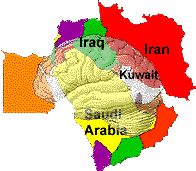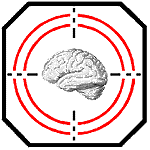 | Brain Abnormalities in Gulf War Veterans |
 | Brain Abnormalities in Gulf War Veterans |
| June 9, 2000
Gulf War SyndromeFor some of the 697,000 American men and women who served in the Persian Gulf region during Operation Desert Storm, the battles were not over when the fighting stopped. When many soldiers returned to the United States in 1991, they fought for their health against an illness termed "Gulf War Syndrome." Symptoms of this disorder include:
|

|
| Three different types of Gulf War Syndrome have been identified: | ||
| Syndrome 1 (Impaired Cognition) Symptoms: Depression, concentration difficulties Commonly found in veterans who wore pesticide-containing flea collars. |
Syndrome 2 (Confusion-Ataxia) Symptoms: Thinking and reasoning difficulties, dizziness, balance and coordination problems Commonly found in veterans who said they were exposed to nerve agents. |
Syndrome 3 (Central Pain) Symptoms: Joint and muscle pain, fatigue, numbness and tingling in the arms and legs Commonly found in veterans exposed to insect repellents with the chemical DEET. |
| Although the causes of Gulf War Syndrome are not known for certain, some researchers believe that veterans who developed these symptoms may have been exposed to chemical nerve agents, pesticides or insect repellants. New research using brain scans show that regardless of the presumed cause of the disorder, veterans who have Gulf War Syndrome suffer from nerve cell loss in several areas of the brain. |  |
|
Into the Scanner Using a brain scanning technique called magnetic resonance
spectroscopy (MRS), researchers at the University of Texas
Southwestern Medical Center (Dallas) examined and compared the brains of
symptomatic and asymptomatic Gulf War veterans. The brains of 22 veterans
with Gulf War Syndrome were compared with those from 18 healthy veterans.
All of veterans were in the same military unit during the war.
Researchers who examined the brain images did not know if the images were
from a healthy subject or an ill subject.
Using a brain scanning technique called magnetic resonance
spectroscopy (MRS), researchers at the University of Texas
Southwestern Medical Center (Dallas) examined and compared the brains of
symptomatic and asymptomatic Gulf War veterans. The brains of 22 veterans
with Gulf War Syndrome were compared with those from 18 healthy veterans.
All of veterans were in the same military unit during the war.
Researchers who examined the brain images did not know if the images were
from a healthy subject or an ill subject.In contrast to regular magnetic resonance imaging methods that provide an anatomical view of the brain, MRS methods give researchers a functional view of the brain. MRS works by measuring the concentration of a chemical called N-acetylaspartate (NAA) that is found only in neurons. Reduced amounts of NAA in a particular brain area would indicate impaired neuronal functioning, possibly due to neuronal damage or loss. |
The Basal Ganglia and Pons SufferCompared to the brains of healthy veterans, the brains of veterans with Gulf War syndrome 2 showed abnormalities in three areas:
Reduced NAA values may represent a loss of neurons or damage to neurons so they do not function properly. The data indicate that veterans with the most severe symptoms (syndrome 2) have the most extensive brain damage. Knowledge about the underlying brain changes in veterans with Gulf War Syndrome may help in the diagnosis and treatment of these patients. |

Brain Areas Studied |
For more information about Gulf War Syndrome, please see:
|
References and further information:
|
| GO TO: | Neuroscience In The News | Explore the Nervous System | Table of Contents |
![[email]](./gif/menue.gif) Send E-mail |
 Get Newsletter |
 Search Pages |
 Donate to Neuroscience for Kids |